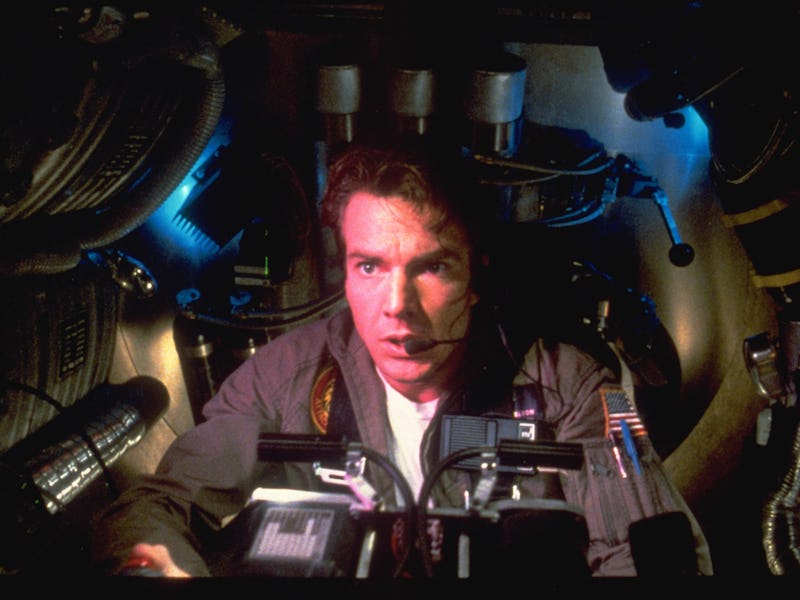You need to watch this hugely underrated sci-fi movie before it leaves HBO Max next week
This comedic take on Fantastic Voyage absolutely holds up.

How do you make a small man bigger? Well, you could try putting a big man inside him.
What sounds on paper like a B-movie snuff film is actually one of the most entertaining sci-fi movies of the ‘80s. In 1987, the same packed year that saw the release of The Lost Boys, Full Metal Jacket, Spaceballs, Predator, Dirty Dancing, RoboCop, and (I’m serious) Ishtar, director Joe Dante and Steven Spielberg came together to deliver a high-concept comedy — one that would leave an impression far bigger than its tiny characters.
Predating modern action-comedies like Marvel’s Ant-Man and “body control” comedies like Pixar’s Ratatouille, the science-fiction spoof Innerspace is the movie you need to stream before it leaves HBO Max on August 31.
Conceptually a comedic take on the 1966 epic Fantastic Voyage, Innerspace stars Martin Short, at the time in the midst of a Hollywood hot streak. Fresh from Saturday Night Live and the 1986 hit Three Amigos, with Steve Martin and Chevy Chase, Short stars as Jack Putter, a wispy and injury-prone grocery clerk who can barely summon respect from others, let alone a date with a nice girl. Jack’s luck shifts after he’s unwittingly injected with a strange serum by a dying scientist.
Jack soon finds that it’s not a matter of what he’s injected with, but who: swaggering Lt. Tuck Pendleton (Dennis Quaid), a playboy Air Force pilot in a top-secret shrinking experiment gone awry. With Pendleton’s oxygen depleting in his microscopic ship, and nefarious competitors out to steal the formula, the two must work together with Tuck’s ex-girlfriend, journalist Lydia (Meg Ryan), to get Pendleton out of Jack’s body and scaled back up to size.
Though hijinks abound — many shouldered by Short’s manic energy — there’s something spiritually uplifting about Innerspace. With an alpha male like Lt. Tuck “inside” the body of the more beta-like Jack, Innerspace is really a story about growth. Jack’s arc involves sticking up for himself, becoming a bigger man like the one mechanically latched onto his innards.
Innerspace, a 1987 comedy about an Air Force pilot who enters the body of a grocery clerk, is streaming on HBO Max until August 31.
In contrast, Tuck’s arc is a bit more abstract but becomes clear by the film’s end. A predecessor to Robert Downey Jr.’s Tony Stark, Tuck is overly-confident and square-jawed, but he hasn’t quite grown up. His immaturity and carelessness, following one particularly embarrassing public bender, caused Lydia to leave him. Though initially unbothered by her exit — watch him smooch a cute scientist like a sailor fresh from war — getting trapped in another man’s body with no easy way out would be enough to make anyone reevaluate their choices in life. Perhaps many of us can relate after a year of confinement thanks to quarantine.
But regardless of the film’s deeper meaning, if any exists, Innerspace is still a triumph of popcorn science-fiction 35 years after its release. It holds up! Though lacking quotable lines and profoundly laugh-out-loud hysterics, the movie goes down easy and breezy.
But as effortless as Innerspace appears, its journey behind the scenes was fraught with road bumps; its concept kept getting rewritten, and a marketing campaign failed to sell the movie to the public. In a 1987 New York Times box office analysis, Innerspace sold a “disappointing” $26 million worth of tickets against a $27 million budget.
Conceived as an intentional parody of Fantastic Voyage by writer Chip Proser, it took a rewrite by Lost Boys scribe Jeffrey Boam for the movie to find its groove. “Innerspace was basically a rip-off of Fantastic Voyage,” admitted Proser in a 2008 interview with Media Pundit. “My idea was that the big guy was up and moving around and could react to what was going on inside.”
Boam was not so hot on Proser’s original script. “The idea was kind of ridiculous, which was a person miniaturized and put into someone else’s body,” Boam said in a 2013 interview. “That’s all I kept from the original script. They originally thought it might be Michael J. Fox inside Arnold Schwarzenegger’s body. I actually kept turning it down, and they were persistent and kept coming back to me.”
Martin Short, Meg Ryan, and Dennis Quaid headline Innerspace, from director Joe Dante.
Dante, too, fought an uphill battle with the film. Though Innerspace is beloved today by ‘80s genre enthusiasts, Dante says it didn’t get much love until the studio released it on home video.
“People don’t really talk to me much about Innerspace,” he said in a 2010 interview with Den of Geek. “It was discovered on video, basically. Although audiences liked it in theatres — when I went, they were in stitches — the ad campaign was so terrible for that movie. It was just a giant thumb with a little tiny pod on it. You couldn’t tell that it was a comedy — you couldn’t tell anything — and it had a terrible title because we could never figure out a better one.”
Though audiences didn’t flock to Innerspace in 1987, its legacy endures today. (And we don’t mean the existence of The Boys star Jack Quaid, son of Dennis Quaid and Meg Ryan, who met on Innerspace and subsequently married.) While Fantastic Voyage is still the touchstone for size-shifting adventures, Innerspace modernized this idea.
You don’t get quantum-centric heists like the ones in Marvel’s Ant-Man movies, nor the humor of a rat controlling a failed chef in Ratatouille, without Dennis Quaid telling Martin Short how to man up in Innerspace. It’s proof that even the little things can make a big difference.
Innerspace is streaming now on HBO Max until August 31.